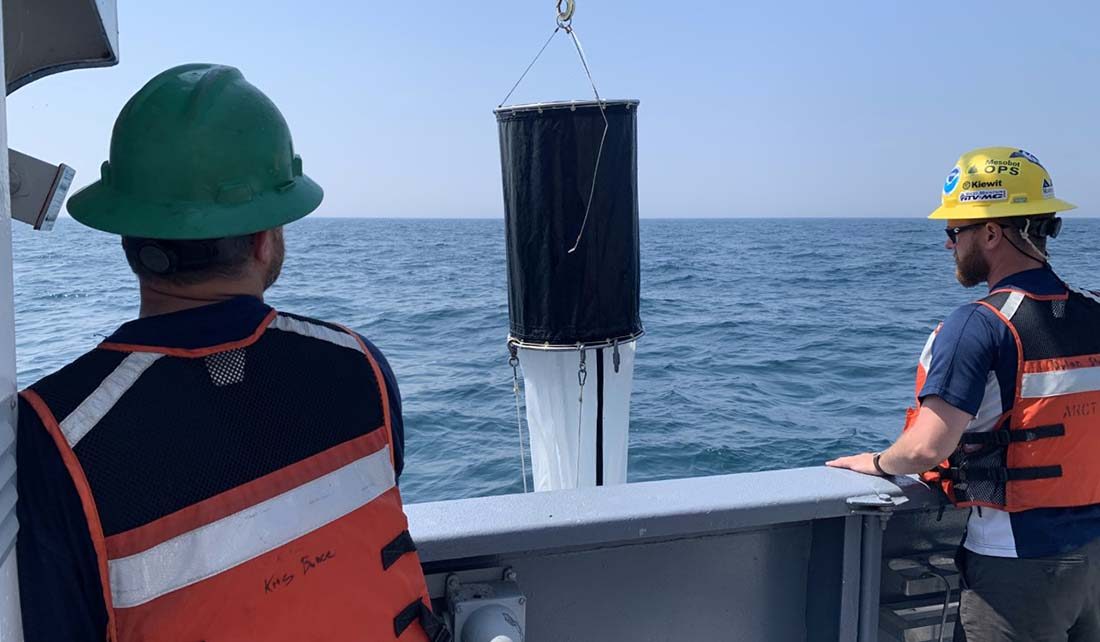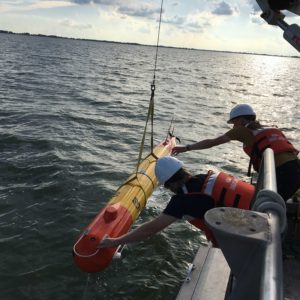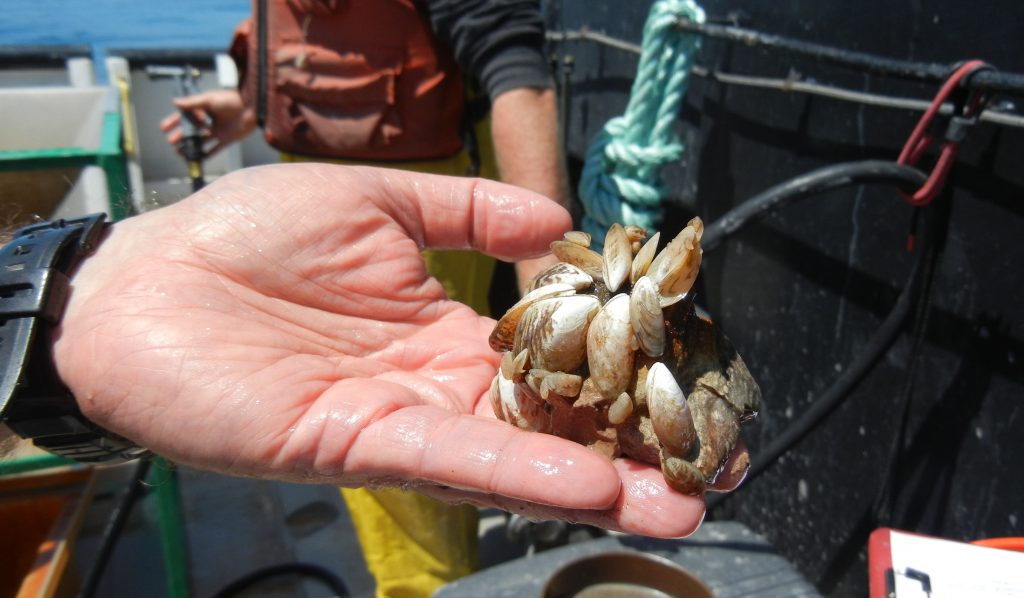
CSMI, or the Cooperative Science and Monitoring Initiative, is an internationally-supported endeavor to collect and process data about the Great Lakes. Each year, scientists study a different Laurentian Great Lake. They spend up to a month on ships for their research, and to work together to answer broad questions about the health of the lake, generating data and information to help improve environmental management.
Lake Michigan was scheduled to be sampled in 2020, so IISG hosted the kickoff workshop funded by the International Joint Commission in 2018 to discuss sampling priorities. Unfortunately, the COVID pandemic delayed sampling, so in 2021 CSMI research focused on both Lake Michigan and Lake Superior, meaning ships and people had to split their time between the two lakes. While COVID protocols remained in place, researchers were tenacious and gathered exciting data.

Long-range autonomous underwater vehicles can sample 24 hours a day, seven days a week, for as much as a couple of weeks at a time according to David Warner of USGS. (NOAA Great Lakes Environmental Research Laboratory)
A key theme during 2021 sampling of Lake Michigan was to collect data from a broader area than had been done during previous field years. While physical researchers and biologists from the NOAA Great Lakes Environmental Research Laboratory (NOAA-GLERL) deployed buoys and autonomous underwater vehicles—and conducted larval fish and other biotic sampling—off the coast of the long-sampled Muskegon, Michigan transect, researchers from the EPA Great Lakes Toxicology and Ecology Division Laboratory (EPA-GLTED), the USGS Great Lakes Science Center (USGS-GLSC) and other organizations also sampled extensively in the less-studied northern portion of Lake Michigan, plus included sampling of Green Bay and Grand Traverse Bay.
This intentional effort on the part of the researchers was designed to make the most of the longer-term datasets from the southern portion of the lake, while also filling in important data gaps to increase overall understanding of Lake Michigan ecosystems.
With regard to longer-term sampling, biologists from Buffalo State College, the EPA-GLTED office and NOAA-GLERL all gathered samples to explore the lower food web, including phytoplankton, zooplankton and benthic macroinvertebrates. Many of these sampling efforts are similar to Lake Michigan sampling efforts in 2010 and 2015, including using a benthic sled to assess benthic communities. Repeating sampling at the same locations, in the same ways, can help biologists understand if the food web makeup is changing or remaining the same.

Rock covered in quagga mussels, collected in a Ponar grab in Lake Michigan during the 2015 CSMI benthic survey. (NOAA Great Lakes Environmental Research Laboratory)
NOAA-GLERL scientists also continue to explore the biology of invasive quagga mussels. Quagga mussels, which have largely replaced zebra mussels across the Great Lakes, have completely reengineered Lake Michigan by altering phytoplankton dynamics, providing new sources of food for other Lake Michigan organisms, and altering habitat characteristics along the lake bottom.
In 2021, a NOAA-GLERL-led team is focused specifically on assessing quagga mussel length-weight relationships and reproductive status. They are also examining veligers, which are very small, young mussels that are almost microscopic. The veliger stage is the only time that quagga mussels move freely with currents, and small fish and zooplankton likely take advantage of veligers as a food source.
Scientists from Wayne State University worked with NOAA-GLERL researchers to see if laboratory-reared larval yellow perch that were fed veligers performed less well than those fed other zooplankton. Preliminary results suggest that feeding on veligers can negatively affect larval yellow perch growth, making it important to gain a greater understanding of when and where veligers are available for organisms to eat so that scientists can understand the growth of all Lake Michigan fishes.
One of the most exciting efforts of the 2021 Lake Michigan CSMI sampling year is a major push to understand distributions and growth of young fish, including alewives, yellow perch and lake whitefish. Sampling conducted during the 2015 CSMI effort found that larval alewife growth in Lake Michigan had slowed about 40% since the early 2000s. Alewife are ecologically critical prey for larger fishes in Lake Michigan, and it is unclear if slower growth rates are related to food availability, food quality or other factors.
A team led by NOAA-GLERL did an intensive study along the Muskegon, Michigan transect to assess dynamics of all available larval and juvenile fish, including assessing the importance of night and day, depth, distance from shore and a large number of physical and abiotic variables, such as temperature and dissolved oxygen, on fish diets and growth. The team plans to combine their findings with efforts by the USGS Great Lakes Science Center and the EPA Great Lakes Toxicology and Ecology Division Laboratory, who in July sampled 15 transects across all of Lake Michigan for plankton and larval fish.
At each transect, the EPA team also measured the depth that UV radiation now penetrates. Water clarity in Lake Michigan has increased over the past 15 years, in part because quagga mussels have expanded to deeper portions of the lake, and it is possible that UV rays harm larval fish. This is likely the largest spatial coverage for larval fish sampling that has ever been undertaken in Lake Michigan, and nicely showcases what can happen when sampling among organizations is coordinated.
In early 2021, the USGS Great Lakes Science Center conducted weekly sampling of larval lake whitefish and available zooplankton prey along the beaches of St. Joseph and South Haven, Michigan; the southernmost locations in Lake Michigan to be sampled for lake whitefish larvae. By combining the results from these efforts with long-term lake whitefish beach sampling studies conducted by NOAA-GLERL and the Little Traverse Bay Bands of Odawa Indians (LTBB), scientists will better understand whether lake whitefish recruitment could be limited by zooplankton prey in their first weeks of life.
Purdue University scientists were also able to examine diets of larval whitefish collected from 2015 through 2019 by the LTBB, after samples were graciously provided, and plan to assess diet and growth patterns of larval alewife collected in southeastern Lake Michigan in 2021. All teams are eager to learn more about the larval fish community in the coming months as they shift from intensive field sampling to laboratory processing: measuring larval fishes, counting what is in their diets, and assessing growth.
The studies summarized here are far from the only efforts by scientists to understand Lake Michigan in 2021. Physical scientists at NOAA-GLERL deployed buoys and autonomous underwater vehicles to collect physical, chemical and biological observations in Lake Michigan, and NOAA-GLERL modelers created biophysical models to help visualize the movement of water and predict the locations of larval fish. USGS-GLSC scientists leveraged the existing Great Lakes Acoustic Observation System (GLATOS) network to better understand how lake whitefish and cisco select their habitats, and biologists were out as late as November 2021, tagging fish that will be tracked through 2022.
Scientists from several different partner organizations will use indicators like stable isotope ratios in organisms to determine food web structure, and further understand how energy is passed among Lake Michigan organisms. Illinois-Indiana Sea Grant looks forward to working with CSMI scientists to share the results of their work through online materials, presentations at conferences and written reports. To learn more about the 2015 CSMI Lake Michigan Field Year results, explore the story map Lake Michigan Health: A Deeper Dive.
Illinois-Indiana Sea Grant is a part of University of Illinois Extension and Purdue Extension.
Writer: Carolyn Foley
Contact: Paris Collingsworth


